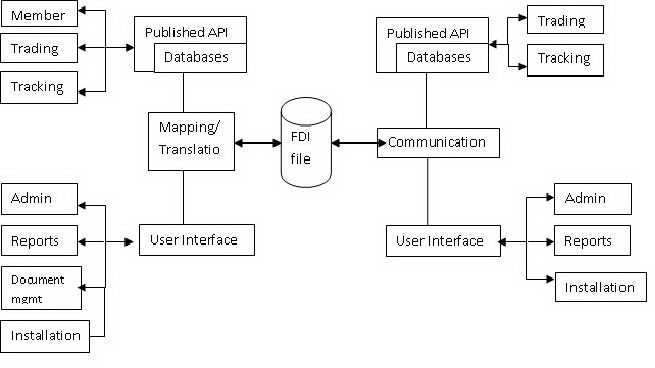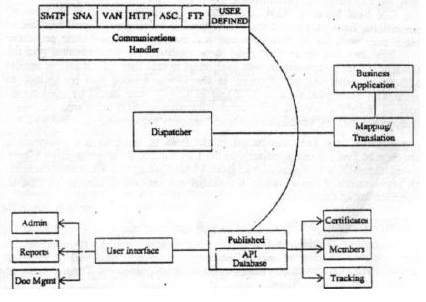EDI Architecture:
EDI architecture provides a framework that enables you to standardize the information which can be easily exchanged between and within business organizations and government entities using electronic channels. The two types of EDI architecture are as follows:
• Older EDI architecture
• Web-enabled EDI architecture
Older EDI architecture:
The older EDI architecture provides a framework that includes different technologies as components. These components enable you to exchange the information between and within business organizations. The following figure shows the architecture of an older EDI.

Web-enabled EDI architecture:
The Web-enabled EDI architecture provides a framework that includes different technologies as components into the system. The Web-enabled EDI system uses the server as an additional component, which incorporates the Internet-related protocols' for communication, the following figure shows the architecture of the Web enabled EDI.

The common components of both types of EDI architectures are as follows:
•The Application Programming Interface (API): It handles business documents or data and also processes the incoming data that is generated by the application system.
• The EDI interface: The EDI interface system helps us handle and process the EDI transactions. The EDI interface includes two parts where one part is the application interface, which moves the electronic transactions to and from the application system, and the other part is the EDI translator, which translates between the standard formats and the internal system formats.
• The communication system: It includes the process in which the communication interface transmits the translated data to the network and receives the incoming data. It includes the controls to ensure that the data is sent and received properly and to detect any errors or failures.
Interpretation of Data:
EDI specifications do not specify the way the information should be interpreted by the business receiving it. This can only be achieved with the help of EDI translation software that is used to assist business organizations to understand the information contained in the EDI specification.
For an inbound document, the EDI application validate the received the message and it also validates that the trading partner who is sending the file is a valid trading partner. VAN also validates that the structure of the file meets the EDI standards and the individual fields of information conform to the agreed-upon standards. The translators will create a file of either fixed length or variable length that will be converted into the format understandable by the business systems of different organizations. After this, the convened file will be stored in the database maintained by the organizations.
The process of exchanging an outbound document is just the reverse of the process of an inbound document. The integrated EDI retrieves the document from the database of the company and converts it into a format the translator can understand. The translator, which is the software, then verifies the converted document for the standards set up by the trading partners. The translator software always converts this file into an EDI format by merging' the appropriate identifiers and control structures. After this, the file will be sent to the trading partner by using appropriate protocols.
It is also the responsibility of the EDI translation software to inspect all the steps that have been performed while transferring the document between the business partners. The, inspection is done to make sure that no data has been lost while transferring the document from one location to another.
Therefore, the translator proves to be a very useful software in the EDI technology. It can be used by the sender of the EDI message to convert the file from the electronic version to the standardized format understandable by the buyer. It also hides the details of the changes made by one partner from another partner. Translation software tends to accommodate a wide range of proprietary file formats so that they can be used to support EDI transactions on a wide range of existing systems.
Security Methods for E-commerce

